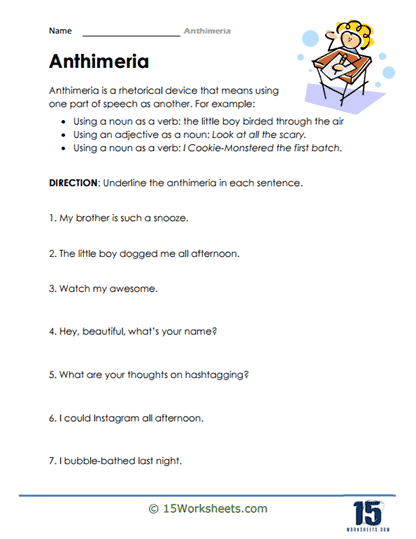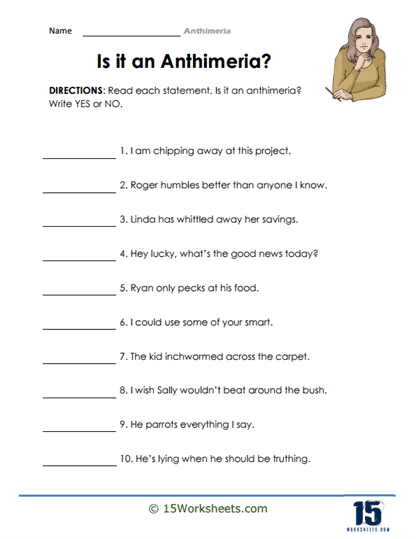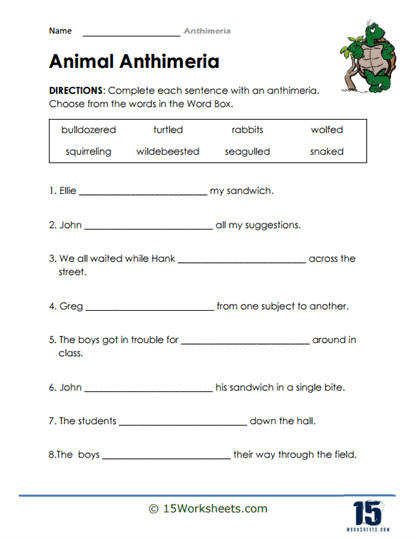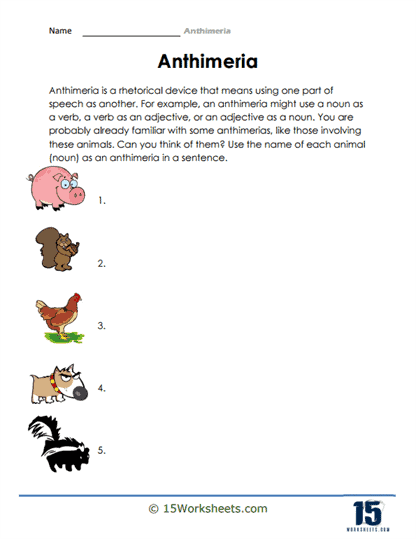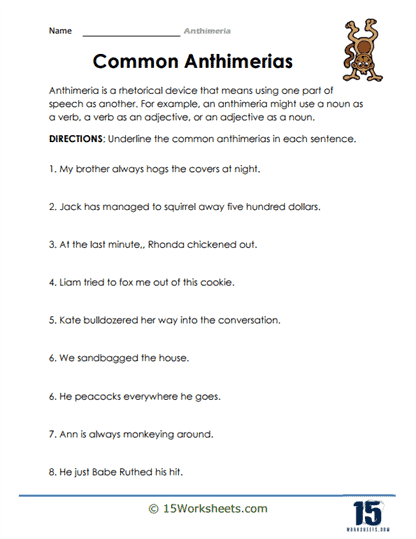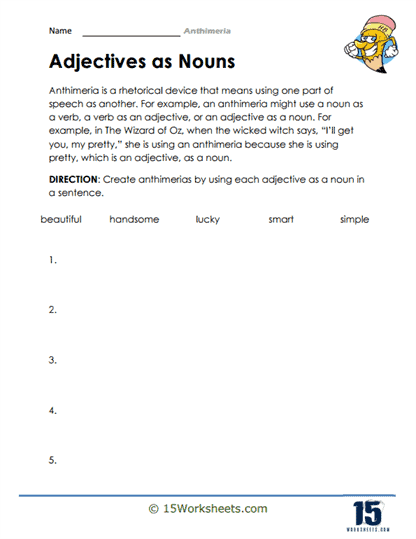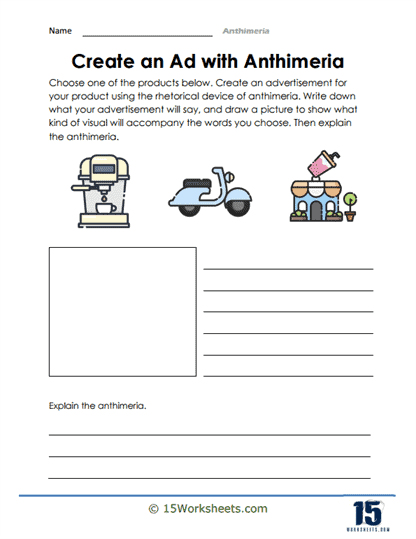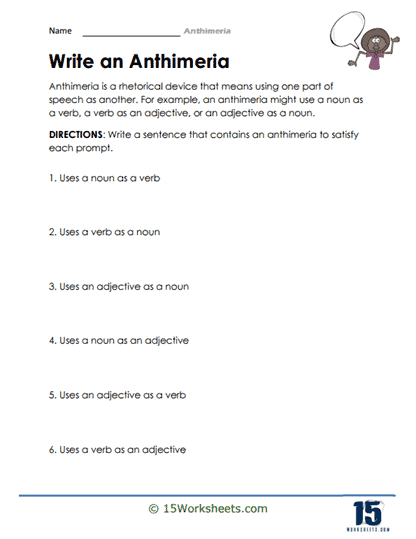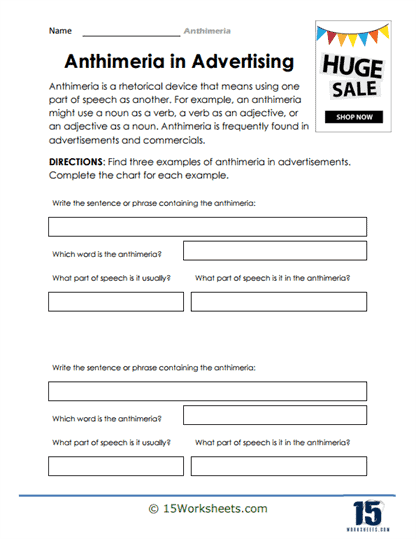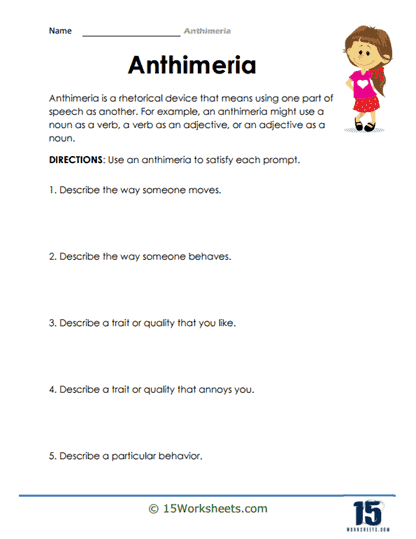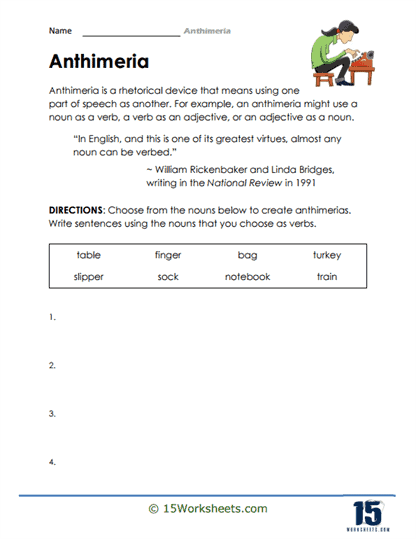Anthimeria Worksheets
All About These 15 Worksheets
Anthimeria, the literary device that involves using one part of speech in place of another, is a fascinating linguistic phenomenon that enriches vocabulary, encourages creative expression, and enhances language flexibility. Understanding and mastering anthimeria is not just about linguistic acrobatics; it’s about fostering language creativity, expanding communication skills, and deepening language comprehension.
In an age where effective communication and language versatility are paramount, students must develop the ability to recognize and employ anthimeria in their writing and speech. To empower students with the art of anthimeria and its myriad applications, we proudly present a collection of 15 worksheets on Anthimeria. These worksheets are meticulously designed to provide students with structured and engaging opportunities to explore, practice, and master the art of anthimeria.
What Is Anthimeria And What Is The Goal Of These Worksheets?
These are fun activities that help you learn about a cool language trick called anthimeria. Anthimeria is when you use a word from one part of speech in a different part of speech. For example, using a noun as a verb or a verb as a noun.
In these worksheets, you’ll see examples of words being used in unexpected ways. You might have sentences where a noun is used as a verb or a verb is used as a noun. Your task will be to identify the anthimeria and understand how it changes the meaning or adds creativity to the sentence.
The goal of the worksheets is to help you become more playful and creative with language. Anthimeria allows you to see words in new and exciting ways, making your writing more interesting and unique.
Why Do Authors Use Anthimeria As A Literary Device?
Authors use anthimeria as a literary device for several reasons. Here are five examples:
Adding Creativity and Expressiveness
Anthimeria allows authors to play with language and add creativity to their writing. By using words in unexpected ways, such as turning a noun into a verb or vice versa, authors can create unique and expressive expressions. For instance, Shakespeare’s famous line “The lady doth protest too much” from Hamlet uses the verb “protest” in a way that transforms it into a descriptor of the lady’s actions.
Enhancing Figurative Language
Anthimeria can be used to create powerful metaphors or similes. By applying a word from one part of speech to another, authors can evoke vivid imagery and convey complex emotions or ideas. In Maya Angelou’s poem “Caged Bird,” she writes, “The caged bird sings with a fearful trill.” Here, the verb “sings” is used to describe the bird’s vocalization, creating a metaphorical expression of the bird’s desire for freedom.
Portraying Character Traits or Speech Patterns
Anthimeria can be used to depict a character’s unique speech style or personality. By having a character use words in unconventional ways, authors can develop distinct voices and memorable traits. In J.D. Salinger’s novel “The Catcher in the Rye,” the protagonist Holden Caulfield often uses nouns as adjectives, such as “phony” or “crumby,” to convey his critical and cynical perspective.
Creating Wordplay and Humor
Anthimeria can generate wordplay and add humor to a narrative. By using words in unexpected ways, authors can create puns, jokes, or humorous situations. In Lewis Carroll’s “Alice’s Adventures in Wonderland,” the Mad Hatter’s famous line “I’m late! I’m late! For a very important date!” uses the adjective “late” as a noun, creating a playful and nonsensical expression.
Capturing Linguistic Realism or Change
Anthimeria can reflect linguistic shifts or the evolving nature of language. By showing characters using words in unconventional ways, authors can mirror the fluidity and adaptability of language over time. In James Joyce’s novel “Ulysses,” the character Stephen Dedalus states, “Shakespeare is the happy hunting ground of all minds that have lost their balance.” Here, the noun “hunting ground” is used to describe a mental state, capturing the character’s unique perspective.
The Importance of Understanding Anthimeria
Understanding anthimeria and its various forms is of great importance for several reasons:
- Vocabulary Enrichment: Anthimeria encourages students to explore and utilize a wide range of words and expressions, expanding their vocabulary.
- Creative Expression: Mastery of anthimeria empowers students to play with language, fostering creative and imaginative expression in their writing and speech.
- Effective Communication: Learning to employ anthimeria enhances students’ ability to convey ideas vividly and succinctly, making their communication more engaging and impactful.
- Literary Appreciation: Anthimeria is a device often used in literature and poetry, and understanding it allows students to appreciate the artistry of language in literary works.
Benefits Of These Anthimeria Worksheets For Students
This collection of Anthimeria worksheets offers numerous advantages for students:
- Structured Learning: The worksheets are thoughtfully organized to provide students with a structured learning experience. They progress from basic anthimeria concepts to more advanced linguistic creativity, ensuring a comprehensive understanding.
- Engaging Activities: Each worksheet incorporates fun and interactive activities, including identifying anthimeria in literature, creating anthimeric expressions, and crafting anthimeric sentences. These activities make learning about anthimeria enjoyable, keeping students motivated and interested.
- Versatility: These worksheets can be used in various educational settings, including language arts classes, creative writing workshops, and vocabulary-building exercises. They are adaptable to students of different ages and proficiency levels.
- Enhanced Linguistic Skills: Proficiency in understanding and employing anthimeria sharpens students’ language flexibility, allowing them to use language creatively and effectively.
- Critical Thinking: Analyzing anthimeria challenges students to think critically about language, explore wordplay, and appreciate the nuances of expression.
These Anthimeria worksheets are valuable resources for educators and parents committed to nurturing language creativity, critical thinking, and effective communication in students. Proficiency in recognizing, creating, and appreciating anthimeria equips individuals with the tools to engage with language on a deeper level, enhance their expression, and appreciate the artistry of wordplay.
This collection is an investment in their future success, ensuring they have the language skills to communicate with creativity, flexibility, and impact. Explore these worksheets with your students today, and watch them embark on a journey of linguistic exploration and wordplay mastery.

